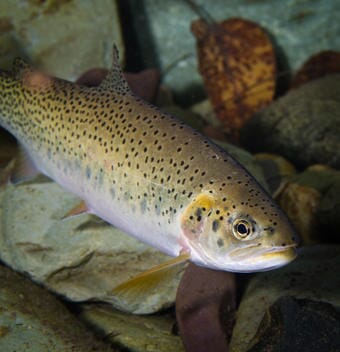Using data from one of the most comprehensive long-term genetic monitoring programs worldwide, the study shows that widespread introductions of invasive rainbow trout and recent climatic variation were associated with the spread of hybridization in native westslope cutthroat trout populations across the United States’ northern Rocky Mountains. The spread of hybridization across space and time was primarily driven by historical stocking practices and exacerbated by warmer water temperatures, higher road densities and lower spring precipitation.
“Our results show that climatic changes are interacting with legacies of rainbow trout introduction and habitat degradation to threaten native cutthroat trout, as invasive rainbow trout continue to expand their range across the northern Rockies,” said lead author and USGS scientist Clint Muhlfeld.
“The loss of native genomes from hybridization is a scenario being realized currently and one that will only proceed into the future, representing a critical threat to native trout persistence," he added.
Researchers used genetic data from 12,878 individual fish from 582 locations in 17 major river basins, climate predictions, and detailed historical stocking records from 1924-1980 for approximately 200 million introduced rainbow trout. The study found hybridization is increasing over a broad geographic region despite ending stocking practices nearly 40 years ago. Data going back to the 1980s show that 50 percent of sites with long-term data show increases in hybridization, the majority of which were initially genetically pure.

Although streams with warmer water temperatures were more prone to hybridization, most hybridized sites (approximately 60 percent) had cold mean summer water temperatures. These findings are counter to the notion that cold headwater streams will serve as a refuge that prevent hybridization.
“Our data clearly show that cold headwater streams are not immune to rainbow trout invasion and hybridization with native cutthroat trout, especially those in close proximity to historical stocking sites,” said Muhlfeld. “Conservation strategies based solely on temperature criteria may seriously underestimate the threat of rainbow trout invasion and hybridization with native trout populations in headwater streams.”
In the western US, genetically pure cutthroat trout populations represent only a fraction of their historical range and genetic diversity, and the spread of hybridization with introduced rainbow trout represents one of the leading threats to remaining populations. The study underscores the value of long-term monitoring data for detecting how historical invasive species introductions interact with contemporary climate warming to promote irreversible evolutionary changes in native species.
“This research shows that human activities can have long-lasting and increasingly synergistic impacts on biodiversity, including species of recreational value like native trout,” said co-author and USGS scientist Ryan Kovach.
Hybridization between native and non-native species is likely to increase in the coming years due to climate-induced expansions of invasive species. Conservation strategies that mitigate existing human stressors, such as translocation of species and habitat modification that interact with climate to promote the expansion of invasive species, will be crucial for conserving biodiversity and preventing genomic extinction of additional population and eventually entire lineages of native cutthroat trout.
The full article, which was published in Global Change Biology, is titled “Legacy introductions and climatic variation explain spatiotemporal patterns of invasive hybridization in a native trout.”
This study was supported by the USGS National Climate Change and Wildlife Science Center, Montana Fish, Wildlife & Parks, University of Montana Flathead Lake Biological Station, University of Montana Conservation Genetics Laboratory, and the National Science Foundation.
More information about impacts and prevention of invasive species and hybridization can be found on the USGS Northern Rocky Mountain Science Center website.



